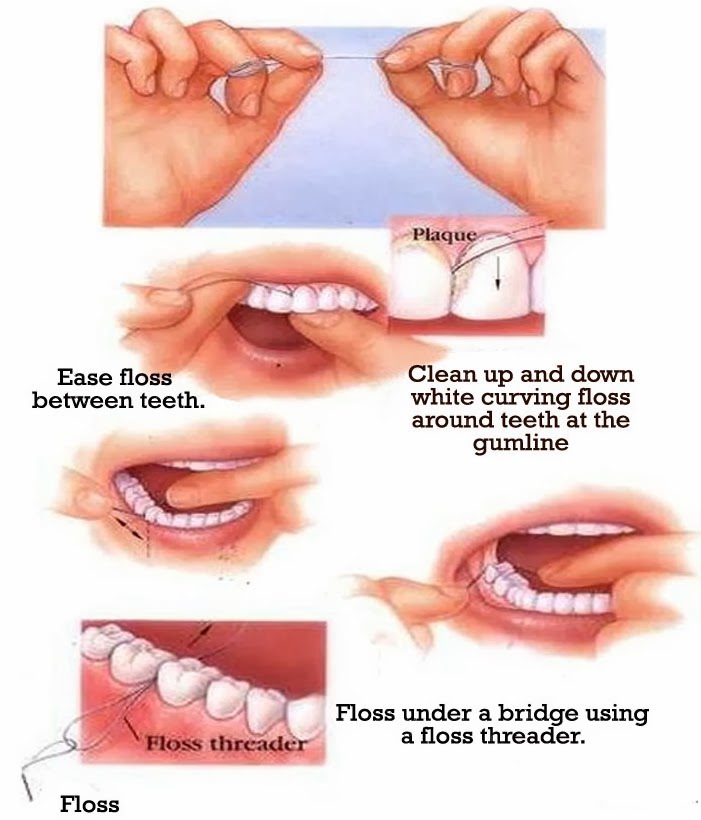Dental FLOSS is the most important thing, next to brushing, for maintaining a good oral hygiene. This is an effective method for removal of plaque and debris from in between the two teeth, where a tooth brush may fail to reach because of tight contact between the two adjacent teeth. So it can also be referred to as an inter-dental cleaner. Most dentists agree that the combination of brushing and flossing is the most effective way of removing plaque from all surfaces of the teeth.
Types of Dental Floss
Dental floss is available as a multifilament nylon yarn. It is further divided into various types according to its form and material, the various types are as follows-
1. Twisted or Non Twisted
2. Bonded or Non Bonded
3. Waxed or Non Waxed
4. Thick or Thin
5. Flavored or Unflavored
Flossing Aids
A flossing aid is designed to help people who find it difficult to do flossing. However there are various types of aids which are designed to make this easier to do. These include:
1. Vibrating dental flosser
2. Dental floss holder
3. Flossing stick
Advantages of Flossing
1. Proper flossing removes plaque and food particles from sites where a toothbrush cannot reach like under the gum-line and in between the teeth.
2. It stimulates gums, polishes tooth surfaces, reduces gum bleeding and prevents gum disease.
3. Flossing prevents plaque build up, thus, reducing the incidence of dental caries.
Frequency of Flossing
It is a good practice to floss your teeth twice daily or atleast once a day. Ideally, flossing should be done after each time you brush your teeth. It should be included as a part of daily oral hygiene routine.
Technique of Flossing
1. 18 inches (approx.) of floss is wrapped around the middle finger of the right hand .The rest is used to secure floss to the middle finger of the left hand .
2. The floss is passed over the tips of the thumbs keeping them one inch apart.
3. The floss is passed gently between each pair of teeth in a gentle sawing motion; it is then curved into C shape around the tooth and is rubbed up and down.
4. The similar method is followed for other teeth.
5. The next length of the floss is taken when the present one gets soiled or frayed.
6. Flossing can be made easier by using floss holders. Floss holder has one or two forks that are rigid, to keep the floss taut when penetrating into tight contact areas. On these forks the mounting of the floss is easy and they hold the floss firmly in place.
Types of Dental Floss
Dental floss is available as a multifilament nylon yarn. It is further divided into various types according to its form and material, the various types are as follows-
1. Twisted or Non Twisted
2. Bonded or Non Bonded
3. Waxed or Non Waxed
4. Thick or Thin
5. Flavored or Unflavored
Flossing Aids
A flossing aid is designed to help people who find it difficult to do flossing. However there are various types of aids which are designed to make this easier to do. These include:
1. Vibrating dental flosser
2. Dental floss holder
3. Flossing stick
Advantages of Flossing
1. Proper flossing removes plaque and food particles from sites where a toothbrush cannot reach like under the gum-line and in between the teeth.
2. It stimulates gums, polishes tooth surfaces, reduces gum bleeding and prevents gum disease.
3. Flossing prevents plaque build up, thus, reducing the incidence of dental caries.
Frequency of Flossing
It is a good practice to floss your teeth twice daily or atleast once a day. Ideally, flossing should be done after each time you brush your teeth. It should be included as a part of daily oral hygiene routine.
Technique of Flossing
1. 18 inches (approx.) of floss is wrapped around the middle finger of the right hand .The rest is used to secure floss to the middle finger of the left hand .
2. The floss is passed over the tips of the thumbs keeping them one inch apart.
3. The floss is passed gently between each pair of teeth in a gentle sawing motion; it is then curved into C shape around the tooth and is rubbed up and down.
4. The similar method is followed for other teeth.
5. The next length of the floss is taken when the present one gets soiled or frayed.
6. Flossing can be made easier by using floss holders. Floss holder has one or two forks that are rigid, to keep the floss taut when penetrating into tight contact areas. On these forks the mounting of the floss is easy and they hold the floss firmly in place.
F shaped and Y shaped dental floss wands
These F and Y shaped wands are specialized plastic wands used to hold the floss. This makes it easier to use the floss on all the surfaces of the teeth where it may be difficult for our finger to reach.
For Medical Diploma
Contacts: 9 abbas el-akkad street, nassr city, Cairo, Egypt
Tel: (+202) 24010655
Cell phone: (+2) 01143050023
Call phone: (+2) 01024212175
E-mail: info@spc-eg.com

.jpg)
ليست هناك تعليقات:
إرسال تعليق